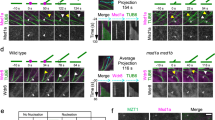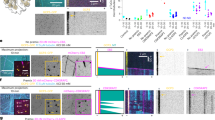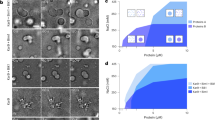Abstract
Microtubule nucleation in interphase plant cells primarily occurs through branching from pre-existing microtubules at dispersed sites in the cell cortex1,2,3. The minus ends of new microtubules are often released from the sites of nucleation, and the free microtubules are then transported to new locations by polymer treadmilling1. These nucleation-and-release events are characteristic features of plant arrays in interphase cells, but little is known about the spatiotemporal control of these events by nucleating protein complexes. We visualized the dynamics of two fluorescently-tagged γ-tubulin complex proteins, GCP2 and GCP3, in Arabidopsis thaliana. These probes labelled motile complexes in the cytosol that transiently stabilized at fixed locations in the cell cortex. Recruitment of labelled complexes occurred preferentially along existing cortical microtubules, from which new microtubule was synthesized in a branching manner, or in parallel to the existing microtubule. Complexes localized to microtubules were approximately 10-fold more likely to display nucleation than were complexes recruited to other locations. Nucleating complexes remained stable until daughter microtubules were either completely depolymerized from their plus ends or released by katanin-dependent severing activity. These observations suggest that the nucleation complexes are primarily activated on association with microtubule lattices, and that nucleation complex stability depends on association with daughter microtubules and is regulated in part by katanin activity.
This is a preview of subscription content, access via your institution
Access options
Subscription info for Japanese customers
We have a dedicated website for our Japanese customers. Please go to natureasia.com to subscribe to this journal.
Buy this article
- Purchase on SpringerLink
- Instant access to full article PDF
Prices may be subject to local taxes which are calculated during checkout





Similar content being viewed by others
References
Shaw, S., Kamyar, R. & Ehrhardt, D. Sustained microtubule treadmilling in Arabidopsis cortical arrays. Science 300, 1715–1718 (2003).
Chan, J. et al. EB1 reveals mobile microtubule nucleation sites in Arabidopsis. Nat. Cell Biol. 5, 967–971 (2003).
Murata, T. et al. Microtubule-dependent microtubule nucleation based on recruitment of γ-tubulin in higher plants. Nat. Cell Biol. 7, 961–968 (2005).
Bartolini, F. & Gundersen, G. G. Generation of noncentrosomal microtubule arrays. J. Cell Sci. 119, 4155–4163 (2006).
Mazia, D. Centrosomes and mitotic poles. Exp. Cell Res. 153, 1–15 (1984).
Wasteneys, G. O. & Williamson, R. E. Reassembly of microtubules in Nitella tasmanica: assembly of cortical microtubules in branching clusters and its relevance to steady-state microtubule assembly. J. Cell Sci. 93, 705–714 (1989).
Chan, J., Sambade, A., Calder, G. & Lloyd, C. Arabidopsis cortical microtubules are initiated along, as well as branching from, existing microtubules. Plant Cell 21, 2298–2306 (2009).
Dixit, R. & Cyr, R. Encounters between dynamic cortical microtubules promote ordering of the cortical array through angle-dependent modifications of microtubule behavior. Plant Cell 16, 274–284 (2004).
Ehrhardt, D. W. & Shaw, S. L. Microtubule dynamics and organization of the plant cortical array. Annu. Rev. Plant Biol. 57, 859–875 (2006).
Wiese, C. & Zheng, Y. Microtubule nucleation: γ-tubulin and beyond. J. Cell Sci. 119, 4143–4153 (2006).
Binarová, P. et al. γ-tubulin is essential for acentrosomal microtubule nucleation and coordination of late mitotic events in Arabidopsis. Plant Cell 18, 1199–1212 (2006).
Pastugilia, M. et al. γ-tubulin is essential for microtubule organization and development in Arabidopsis. Plant Cell 18, 1412–1425 (2006).
Kong, Z, Hotta, T., Lee, Y. J. & Liu, B. The γ-tubulin complex protein GCP4 is required for organizing functional microtubule arrays in Arabidopsis thaliana. Plant Cell 22, 191–204 (2010).
Zeng, C. J. T., Lee, Y.-R. J. & Liu, B. The WD40 repeat protein NEDD1 functions in microtubule organization during cell division in Arabidopsis thaliana. Plant Cell 21, 1129–1140 (2009).
Nakamura, M. & Hashimoto, T. A mutation in the Arabidopsis γ-tubulin-containing complex subunit causes helical growth and abnormal microtubule branching. J. Cell Sci. 122, 2208–2217 (2009).
Seltzer, V. et al. Arabidopsis GCP2 and GCP3 are part of a soluble γ-tubulin complex and have nuclear envelope targeting domains. Plant J. 52, 322–331 (2007).
Erhardt, M. et al. The plant Spc98p homologue colocalizes with γ-tubulin at microtubule nucleation sites and is required for microtubule nucleation. J. Cell Sci. 115, 2423–2431 (2002).
Roll-Mecak, A. & Vale, R. D. Making more microtubules by severing: a common theme of noncentrosomal microtubule arrays? J. Cell Biol. 175, 849–851 (2006).
Wasteneys, G. O. Microtubule organization in the green kingdom: chaos or self-order? J. Cell Sci. 115, 1345–1354 (2002).
McNally, F. J. & Vale, R. D. Identification of katanin, an ATPase that severs and disassembles stable microtubules. Cell 75, 419–429 (1993).
Murphy, S. M. et al. GCP5 and GCP6: two new members of the human γ-tubulin complex. Mol. Biol. Cell 12, 3340–3352 (2001).
Liu, B. et al. γ-Tubulin in Arabidopsis: gene sequence, immunoblot, and immunofluorescence studies. Plant Cell 6, 303–314 (1994).
Janson, M. E., Setty, T. G., Paoletti, A. & Tran, P. T. Efficient formation of bipolar microtubule bundles requires microtubule-bound γ-tubulin complexes. J. Cell Biol. 169, 297–308 (2005).
Paredez, A. R., Somerville, C. R. & Ehrhardt, D. W. Visualization of cellulose synthase demonstrates functional association with microtubules. Science 312, 1491–1495 (2006).
Wiese, C. & Zheng, Y. A new function for the γ-tubulin ring complex as a microtubule minus-end cap. Nat. Cell Biol. 2, 358–364 (2000).
Burk, D. H. et al. A katanin-like protein regulates normal cell wall biosynthesis and cell elongation. Plant Cell 13, 807–827 (2001).
Fu, Y., Gu, Y., Zheng, Z. Wasteneys, G. & Yang, Z. Arabidopsis interdigitating cell growth requires two antagonistic pathways with opposing action on cell morphogenesis. Cell 120, 687–700 (2005).
Galatis, B. & Apostolakos P. The role of cytoskeleton in the morphogenesis and function of stomatal complexes. New Phytologist 161, 613–639 (2004).
Nakagawa, T. et al. Development of series of gateway binary vectors, pGWBs, for realizing efficient construction of fusion genes for plant transformation. J. Biosci. Bioeng. 104, 34–41 (2007).
Clough, S. J. & Bent, A. F. Floral dip: a simplified method for Agrobacterium mediated transformation of Arabidopsis thaliana. Plant J. 16, 735–743 (1998).
Nakamura, M., Naoi, K., Shoji, T. & Hashimoto, T. Low concentrations of propyzamide and oryzalin alter microtubule dynamics in Arabidopsis epidermal cells. Plant Cell Physiol. 45, 1330–1334 (2004).
Shaner, N. C. et al. Improved monomeric red, orange and yellow fluorescent proteins derived from Discosoma sp. Red fluorescent protein. Nat. Biotechnol. 22, 1567–1572 (2004).
Crowell, E. F. et al. Pausing of Golgi bodies on microtubules regulates secretion of cellulose synthase complexes in Arabidopsis. Plant Cell 21, 1141–1154 (2009).
Gutierrez, R. et al. Arabidopsis cortical microtubules position cellulose synthase delivery to the plasma membrane and interact with cellulose synthase trafficking compartments. Nat. Cell Biol. 11, 797–806 (2009).
Rubio, V. et al. An alternative tandem affinity purification strategy applied to Arabidopsis protein complex isolation. Plant J. 41, 767–778 (2005).
Fujiwara, M. et al. Proteome analysis of detergent membranes (DRMs) associated with OsRac1 mediated innate immunity in rice. Plant Cell Physiol. 50, 1191–1200 (2009).
Acknowledgements
We thank Y. Fukao and M. Fujiwara (The Plant Science Education Unit, NAIST) for the mass spectrometry analysis, T. Kato for providing the katanin alleles, and D. Moss and R. Gutierrez for helpful discussions. The Arabidopsis Biological Resource Center is acknowledged for providing the genomic clones. M.N. was supported by a JSPS Research Fellowship for Young Scientist. The work was partly supported by a grant (20370023) and Global COE Program in NAIST (Frontier Biosciences: strategies for survival and adaptation in a changing global environment), MEXT, Japan, to T.H., and by endowment funds of the Carnegie Institution for Science to D.W.E.
Author information
Authors and Affiliations
Contributions
All authors designed experiments. M.N. and D.E. performed the experiments, and D.E. and T.H. wrote the paper. All authors analysed the results and edited the manuscript.
Corresponding authors
Ethics declarations
Competing interests
The authors declare no competing financial interests.
Supplementary information
Supplementary Information
Supplementary Information (PDF 1456 kb)
Supplementary Information
Supplementary Information Movie 1 (MOV 1011 kb)
Supplementary Information
Supplementary Information Movie 2 (MOV 1097 kb)
Supplementary Information
Supplementary Information Movie 3 (MOV 11077 kb)
Supplementary Information
Supplementary Information Movie 4 (MOV 1455 kb)
Supplementary Information
Supplementary Information Movie 5 (MOV 1930 kb)
Supplementary Information
Supplementary Information Movie 6 (MOV 2690 kb)
Rights and permissions
About this article
Cite this article
Nakamura, M., Ehrhardt, D. & Hashimoto, T. Microtubule and katanin-dependent dynamics of microtubule nucleation complexes in the acentrosomal Arabidopsis cortical array. Nat Cell Biol 12, 1064–1070 (2010). https://doi.org/10.1038/ncb2110
Received:
Accepted:
Published:
Issue Date:
DOI: https://doi.org/10.1038/ncb2110



